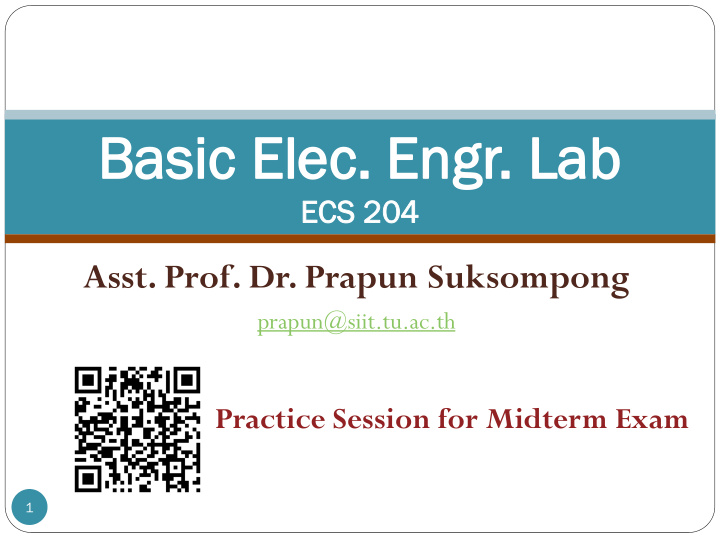



Ba Basi sic c El Elec ec. . En Engr gr. . Lab Lab ECS EC S 204 04 Asst. Prof. Dr. Prapun Suksompong prapun@siit.tu.ac.th Practice Session for Midterm Exam 1
Midterm Work alone Circuit construction and measurement The TAs will not help you debug your circuit. Debug your own circuit. 2
Exam Instructions (1/3) Four sessions session a: 9:30 – 10:30 AM session b: 10:40 – 11:40 AM session c: 1:30 – 2:30 PM session d: 2:40 – 3:40 PM Check your session. Arrive at least 10 minutes early Do not enter the lab before your exam time . Bench numbers for taking exam will be randomly assigned by the instructor. 3
Exam Instructions (2/3) Closed book. Closed notes. No calculator . For the problems that ask for TA’s signatures, lack of the signature(s) means no credit for the whole part . Having the signatures mean that the values recorded are the same as the values measured. These signatures do not guarantee that you have the correct answers. You need a new TA signature if you change your answer. When possible, record at least two decimal places from the DMM. Do not write 12 mA when you see 12.00 mA on the DMM’s display. 4
Exam Instructions (3/3) Read the instructions and the questions carefully . Allocate your time wisely. Some easy questions give many points. Units are important. Do not forget to write your first name and the last three digits of your ID on each page of your examination paper, starting from page 2. Clean your desk/bench before you leave the exam room. 5
Tips Check the current-limit light warning on power supply Usually, connecting the circuit in the same way (components arranged in the same positions and orientation) that is drawn on the exam sheet will make debugging and modification easier. Review how to use “continuity test” on DMM Useful for checking broken wires Battery indicator on DMM Look at what the signature is for. Actual exam is 1 hour. You should be able to finish the practice problems in 45 minutes. 6
Voltage vs. Current Measurements A Curent Measurement Voltage Measurement + I “Break the connection” V V - A 7
Constructing “fake” current source Caution : When the circuit changes, need to readjust (the voltage on the voltage source and hence the current passing though it) back to the specified value. 8
Example 1 (1/2) Suppose you want to construct the following circuit Adjust Vs to make 2mA shows up on the DMM. Note that Vs = 1 V is required to make this happen. 9
Example 1 (2/2) Suppose we want to find the Thevenin equivalent circuit at R L (R L is the load), then need to measure the open circuit voltage of The current source is built in the same way. However, note that the original 1V for Vs will only give 1 mA. So, need to readjust Vs to 2V to get 2mA. 10
Source Deactivation In general, not the same as turning off the power supply. Definition: To deactivate a source means to set its output to be zero. For voltage source, having the value of 0 V means “short” circuit. For current source, having the value of 0 A means “open” circuit. 11
Thevenin’s and Norton’s Theorems V TH = open-circuit voltage Caution: If there is any “fake” current source, need to readjust (the voltage on the voltage source and hence the current passing though I N = short-circuit current it) back to the specified value. R TH = R N = equivalent resistance when all sources are deactivated. For R TH , need to deactivate all the sources in here 12
Recommend
More recommend